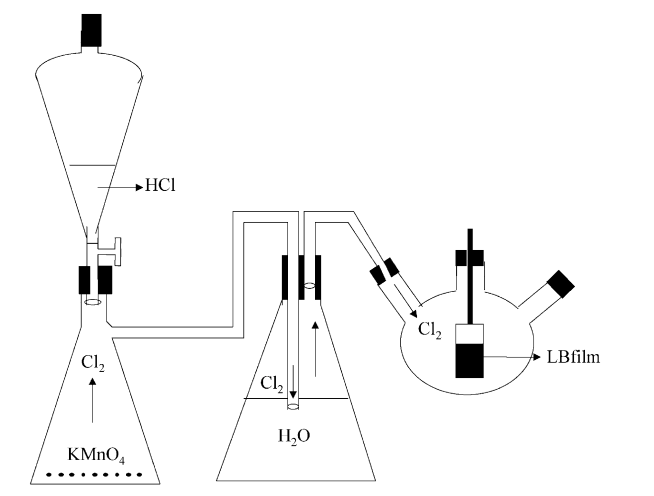1.
Gaffo, Luciana; Couto Jr, Odilon DD; Giro, Ronaldo; Brasil, Maria JSP; Galvao, Douglas S; Cerdeira, Fernando; de Oliveira Jr, Osvaldo N; Wohnrath, Karen
Effects of chlorine gas exposure on the optical properties of rhodium phthalocyanine films Journal Article
In: Solid state communications, vol. 131, no. 1, pp. 53–56, 2004.
@article{gaffo2004effects,
title = {Effects of chlorine gas exposure on the optical properties of rhodium phthalocyanine films},
author = {Gaffo, Luciana and Couto Jr, Odilon DD and Giro, Ronaldo and Brasil, Maria JSP and Galvao, Douglas S and Cerdeira, Fernando and de Oliveira Jr, Osvaldo N and Wohnrath, Karen},
url = {http://www.sciencedirect.com/science/article/pii/S0038109804002996},
year = {2004},
date = {2004-01-01},
journal = {Solid state communications},
volume = {131},
number = {1},
pages = {53--56},
publisher = {Pergamon},
abstract = {We investigated the effects of exposing rhodium phthalocyanine films deposited on glass substrates by the Lagmuir–Blodgett technique to chlorine gas. The visual aspect of the films is altered upon chlorination, changing in color from blue to transparent. We performed optical absorption and Raman Scattering measurements on our films prior to and after exposing it to chlorine gas. We observed a pronounced quenching of the characteristic triplet centered around the Q-absorption band at 662 nm as a result of chlorine incorporation. Another absorption band, in the near UV part of the spectrum, is not greatly affected by the process. No new optical structures appear as a consequence of chlorination. Equivalent effects were observed in the Raman spectra. Leaving the previously exposed films in air for several hours results in a slow partial recovery of the optical spectra. This recovery, as well as the amount of original quenching, depends on the amount of time during which the film was exposed to chlorine.},
keywords = {},
pubstate = {published},
tppubtype = {article}
}
We investigated the effects of exposing rhodium phthalocyanine films deposited on glass substrates by the Lagmuir–Blodgett technique to chlorine gas. The visual aspect of the films is altered upon chlorination, changing in color from blue to transparent. We performed optical absorption and Raman Scattering measurements on our films prior to and after exposing it to chlorine gas. We observed a pronounced quenching of the characteristic triplet centered around the Q-absorption band at 662 nm as a result of chlorine incorporation. Another absorption band, in the near UV part of the spectrum, is not greatly affected by the process. No new optical structures appear as a consequence of chlorination. Equivalent effects were observed in the Raman spectra. Leaving the previously exposed films in air for several hours results in a slow partial recovery of the optical spectra. This recovery, as well as the amount of original quenching, depends on the amount of time during which the film was exposed to chlorine.
2004
1.

Gaffo, Luciana; Couto Jr, Odilon DD; Giro, Ronaldo; Brasil, Maria JSP; Galvao, Douglas S; Cerdeira, Fernando; de Oliveira Jr, Osvaldo N; Wohnrath, Karen
Effects of chlorine gas exposure on the optical properties of rhodium phthalocyanine films Journal Article
In: Solid state communications, vol. 131, no. 1, pp. 53–56, 2004.
Abstract | Links | BibTeX | Tags: Films, Phthalocyanine, Sensors
@article{gaffo2004effects,
title = {Effects of chlorine gas exposure on the optical properties of rhodium phthalocyanine films},
author = {Gaffo, Luciana and Couto Jr, Odilon DD and Giro, Ronaldo and Brasil, Maria JSP and Galvao, Douglas S and Cerdeira, Fernando and de Oliveira Jr, Osvaldo N and Wohnrath, Karen},
url = {http://www.sciencedirect.com/science/article/pii/S0038109804002996},
year = {2004},
date = {2004-01-01},
journal = {Solid state communications},
volume = {131},
number = {1},
pages = {53--56},
publisher = {Pergamon},
abstract = {We investigated the effects of exposing rhodium phthalocyanine films deposited on glass substrates by the Lagmuir–Blodgett technique to chlorine gas. The visual aspect of the films is altered upon chlorination, changing in color from blue to transparent. We performed optical absorption and Raman Scattering measurements on our films prior to and after exposing it to chlorine gas. We observed a pronounced quenching of the characteristic triplet centered around the Q-absorption band at 662 nm as a result of chlorine incorporation. Another absorption band, in the near UV part of the spectrum, is not greatly affected by the process. No new optical structures appear as a consequence of chlorination. Equivalent effects were observed in the Raman spectra. Leaving the previously exposed films in air for several hours results in a slow partial recovery of the optical spectra. This recovery, as well as the amount of original quenching, depends on the amount of time during which the film was exposed to chlorine.},
keywords = {Films, Phthalocyanine, Sensors},
pubstate = {published},
tppubtype = {article}
}
We investigated the effects of exposing rhodium phthalocyanine films deposited on glass substrates by the Lagmuir–Blodgett technique to chlorine gas. The visual aspect of the films is altered upon chlorination, changing in color from blue to transparent. We performed optical absorption and Raman Scattering measurements on our films prior to and after exposing it to chlorine gas. We observed a pronounced quenching of the characteristic triplet centered around the Q-absorption band at 662 nm as a result of chlorine incorporation. Another absorption band, in the near UV part of the spectrum, is not greatly affected by the process. No new optical structures appear as a consequence of chlorination. Equivalent effects were observed in the Raman spectra. Leaving the previously exposed films in air for several hours results in a slow partial recovery of the optical spectra. This recovery, as well as the amount of original quenching, depends on the amount of time during which the film was exposed to chlorine.
http://scholar.google.com/citations?hl=en&user=95SvbM8AAAAJ


